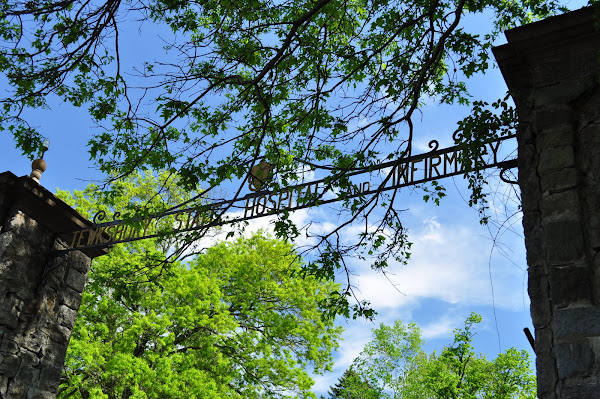There are two cemeteries for Tewksbury State Hospital. The one I visited is called "the Pines Cemetery". The other is simply called "the Pauper Cemetery". They are located in separate woodlands nearby the hospital. According to the Public Health Museum, approximately 15,000 patients, who had no relatives claimed their bodies, are buried in those no-name cemeteries. Apparently, the records between 1854 and 1894 are missing, but at least the patients deceased between1891 and 1930 are buried in the Pines Cemetery. In the Pauper Cemetery, the burials took place as late as 1960's.
Established in 1892, Tewksbury Hospital was originally called as the Tewksbury Almshouse. Many of them were destitute immigrants notably from Ireland. In addition to the poor, they accepted the "pauper insane", alcoholics, and patients with such contagious disease as TB.
Old Administration Building/ Public Health Museum
One of the many reasons why I visited the Public Health Museum was to gather information about the cemetery. Usually, consulting a map and some web sites suffice the function. But look at this...
Google Street View of the Pines Cemetery
No way I'm going to visit the cemetery without the firsthand information, I thought. Helpful guides at the museum provided detailed information about the cemetery, encouraging me to visit there. So I decided to go.
Ok, it doesn't look so intimidating on a hot sunny day. But I didn't bring a bunch of flower...so I went for a rudimentary measure by picking wild flower and put it on a stone hedge. I set my foot onto the pine woods.
There are at least two graves around the snapped tree; click picture to find them
The grave marker in the Pines Cemetery is made of metal and has a cross surrounded by a laurel wreath. Like numerous state hospital cemeteries in Massachusetts, the only information that distinguishes one from another is a number on the center of the cross.
A new guide told me that she was surprised how obscure those markers were when she first visited the cemetery. "If you aren't careful, you'll step on them!" She told me. I was puzzled by her statement because the museum display of the markers were well over 12-inch high.
She was right. Some of the markers were buried deep. 100 years are long time, the forest soil accumulates. The rusty color blended into the surrounding, making it more difficult to spot.
It was the first summer day, hot and humid. Mosquitoes seemed to be waiting for THIS day. I was the prime subject for their feast. I was the walking cocktail platter for them. Why could they sting through my thick, stripy sailor shirt?
Sorry sorry, I forgot a flower bouquet but I searched for an hour...With a rather illogical reasoning for the mosquito siege, I was running through the woods in a nearly panicked state.
Although more sporadic, the markers were located even in the middle of the woods. "How big is the cemetery? Can I go through this?" I began to feel the past and the present were finally connected through the landscape. The sheer number of the anonymous markers spoke about the scale and gravity of the hardship against the destitute.
I finally came to the south side of the cemetery. The grave markers were densely arranged but I somehow felt they were less lonely compared to the sporadically placed markers in the middle of the woods.
One, two, three...Uh-oh
The attack of the mosquitoes became less intense, and I felt more relaxed...But oh boy, I was running on poison ivy.
According to the information in 2004, local volunteers, Eagle Scouts, and Boy Scouts routinely maintain the ground. But it's such a large cemetery; the section the job has done will overgrow again when they finish the last section. Considering from how the grave markers are placed, it is almost impossible to cut the grass with mowing machines. Everything has to be done by hand. Poison Ivy is a big headache among the volunteers.
Fresh paint were on some of the grave markers, suggesting there is a sustained local effort to maintain the ground. But the other location nearby a middle school does not seem to be as maintained as the Pines Cemetery is. Remember, about15,000 people were buried in the two locations. We have a lot of job that has to be done.
RIP
I thank helpful guilds at the Public Health Museum for providing insightful, valuable information of the hospital, cemetery, and history of public health. I recommend you to visit the museum! Museum URL: http://www.publichealthmuseum.org/
Locate Tewksbury State Hospital Cemetery @ Google Map
http://www.tewksburyhospitalcemetery.ma-vitalrecords.org/recordsindex.html
http://www.tewksburyhospitalcemetery.ma-vitalrecords.org/mota.html
http://www.tewksburyissues.org/phpBB3/viewtopic.php?f=65&t=5797






































